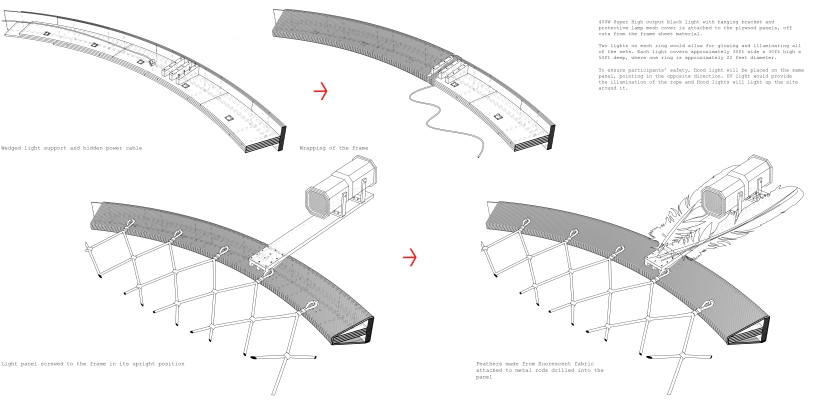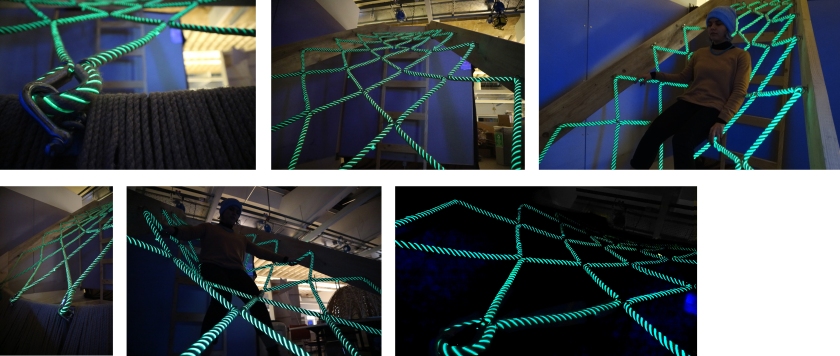
Legend of the Dream Catcher
‘The legend of a dream catcher began long time ago, when the child of a Woodland chief fell ill. Unsettled by fever, the child was plagued with bad dreams and unable to sleep. In an attempt to heal him, the tribe’s Medicine Woman created a device that would ‘catch’ these bad dreams. Forming a circle with a slender willow branch, she filled the centre with sinew, using a pattern borrowed from our brother the Spider, who weaves a web. This dream catcher was then hung over the bed of the child. Soon the fever broke, and the child slept peacefully.
It is said that at night, when dreams visit, they are caught in the dream catcher’s web, and only the good dreams are able to find their way to the dreamer, filtering down through the feather. When the warmth of the morning sun arrives, it burns away the bad dreams that have been caught. The good dreams, now knowing the path,visit again on other nights.’ (Oberholtzer, 2012, p9).
Origins
Dreamcatchers originated with the Ojibwe, a tribe of Native Americans scattered throughout the areas of the lake country in northern Michigan, Wisconsin, and Minnesota, and along the southern border of Canada, along the shores of Lakes Huron, Superior and Michigan, whose survival relied on fishing, hunting and trapping.
Traditionally, the dream catchers were made by tying sinew strands onto a few inches in diameter round or tear-shaped frames of willow and were often wrapped in leather.
The spiritual life of the Ojibwa centred around the Midewiwin, the Grand Medicine Society and focused on the individual spiritual growth, gaining the insight through their dreams or visions.

Mystical Experience
My project is a re-interpretation of the beliefs that dreams have magical qualities with the ability to change or direct one’s path in life. The bawaajige nagwaagan intends to create a mystical experience, where people are caught inside, similar to the way that bad dreams are caught in the dreamcatcher’s web, and good dreams escape through the centre. The participants are encouraged to climb through the centre and escape their bad dreams and feelings, releasing their spirit through the enclosure. Now they can sleep in the peaceful environment, stimulated by the fantasy of glowing feathers and luminescent rope structures. The pavilion aims for people to sleep, relax and free themselves from stress while being protected by the magical webs of the dream catcher.


Romantic essence of the Native American Culture
The proposal is a celebration of the romantic essence of the Native American Culture. The large scale, three dimensional net is inspired by the native methods and techniques of making dream catchers. It is a manifestation of the traditions and significance of the Native Americans, paying respect and pledging support to the indigenous people of America.
The structure situated in the Burning Man festival commemorates the ceremonies of Native Americans, dedicated to acquiring an insight through dreams and visions. Fasting, or giving up of certain necessities for a certain length of time was a common practice used to enhance one’s ability to access different dreams or visions. Another method was to pour water over hot rocks to produce steam, which enhanced the occurrence of dreams, used as source of introspection. These rituals relate to the festival’s assertion of disconnecting from the necessities of our contemporary world, supplemented by the extreme weather conditions, which are hoped to encourage reflection.
The pavilion responds and works together with the Black Rock desert’s environment, and adds to the wider cultural context of leaving behind the essentials and expectations of the contemporary world while creating a moment for contemplation and tranquility in the magical weaves of the dream catcher.

Proposal Development_System




Form Experimentation_Platonic Forms
Hexahedron


Tetrahedron


Physical Description
The structure will be composed out of three, seven meters in diameter, dream catchers, tilted to form a tetrahedron. Each dream catcher’s net will be made out of 275 meters, 18mm, synthetic hemp rope which will be entwined in 1320 meters of 3mm fluorescent cord. Attached to the frame uv lights will make the fluorescent rope glow at night. Three rings hold the net structure together, with the bottom ring anchored to the ground, made out of T-shape plywood frames. The web of the frame will be 4 layers of 15mm ‘banana’ shaped pieces which will create a circle, together with 4 layers of 230mm x 2400mm x 9mm flange pieces bent in shape of the banana edge. Smaller rings, supporting the centre of the dreamcatcher net will be of similar structure, with 2 layers of banana pieces and 2 layers of 150mm x 2400m x 9mm flange pieces, bent in shape. The frame will be wrapped in 13500 meters of 8mm synthetic hemp with attached fluorescent fabric feathers.





UV lighting-Construction Development
Testing Ideas in 1:1 Scale

Assembly of the net is inspired by a macrame knotting technique rather than weaving which means that the net could be made out of smaller 15 meters long pieces, rather than one 275 m coil of rope, making it easier to assemble and repair. Rope is anchored to the frame with thimbles and shackles, attached to the bolted staple on the plate. The rope is connected with simple S-shape stainless steel hooks. After testing the net I found that although these are easy to assemble, they can create some movement in a connection, therefore I am planning on exploring the idea of ferrules, which could be crimped in place.


